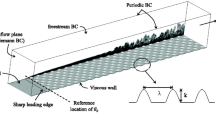Abstract
The qualitative characteristics of laminar-turbulent transition behind a three-dimensional roughness element in a zero-gradient boundary layer are investigated for high supersonic free-stream velocities. Quantitative data on the distribution of the heat transfer coefficient in the neighborhood of the roughness element and in the wake behind it are obtained. Another object of the investigation was to compare the data obtained for the position of the laminar-turbulent transition zone with well-known correlations used in practice.
Similar content being viewed by others
Literature cited
S. A. Gaponov and A. A. Maslov, Development of Disturbances in Compressible Flows [in Russian], Nauka, Novosibirsk (1980).
V. N. Zhigulev and A. M. Tumin, Onset of Turbulence (Dynamical Theory of the Excitation and Development of Boundary Layer Instabilities) [in Russian], Nauka, Novosibirsk (1987).
H. Schlichting, The Origin of Turbulence [Russian translation], Moscow (1962).
I. Tani, “Effect of two-dimensional and isolated roughness on laminar flow,” Boundary Layer and Flow Control, Vol. 2, Pergamon Press, Oxford (1961), p. 637.
A. E. Doenhoff and A. L. von Braslow, “The effect of distributed surface roughness on laminar flow,” Boundary Layer and Flow Control, Vol. 2, Pergamon Press, Oxford (1961), p. 657.
M. M. Ardasheva, V. Ya. Borovoi, R. Z. Davlet-Kil'deev, et al., “Use of thermal indicator coatings in heat transfer research,” Tr. TsAGI, No.1692, 130 (1975).
N. A. Davydova and A. Ya. Yushin, “Nature of the effect of the angle of attack on laminar-turbulent boundary layer transition on the undersurface of plane delta wings at supersonic speeds,” Tr. TsAGI, No.1749, 3 (1976).
E. R. Van Driest and C. B. Blumer, “Boundary-layer transition at supersonic speeds-three-dimensional roughness effects (spheres),” J. Aerosp. Sci.,29, 909 (1962).
J. L. Potter and J. D. Whitfield, “Effects of slight nose bluntness and roughness on boundary-layer transition in supersonic flow,” J. Fluid Mech.,12, 501 (1962).
V. A. Bashkin, “Calculation of the skin-friction and heat transfer coefficients for a plate, a cone and a blunt-nosed body in the neighborhood of the stagnation point in laminar boundary layer flow without allowance for dissociation,” Tr. TsAGI, No. 937, 12 (1964).
V. M. Garbuzov, N. P. Kolina, and A. I. Pyatnova, “Calculation of the skin-friction and heat transfer coefficients for a plate and a sharp cone in a supersonic flow in the presence of a turbulent boundary layer,” Tr. TsAGI, No.1881, 67 (1977).
P. K. Chang, Separation of Flow, Pergamon, Oxford (1970).
M. C. Fischer, “Spreading of a turbulent disturbance,” AIAA J.,10, No. 7 (1972).
E. L. Morrisette, “Roughness-induced transition criteria for space shuttle-type vehicles,” J. Spacecr. Rockets,13, 118 (1976).
J. D. Whitfield and F. A. Iannuzzi, “Experiments on roughness effects on cone boundary-layer transition up to Mach 16,” AIAA J.,7, 465 (1969).
Author information
Authors and Affiliations
Additional information
Translated from Izvestiya Akademii Nauk SSSR, Mekhanika Zhidkosti i Gaza, No. 4, pp. 60–66, July–August, 1990.
Rights and permissions
About this article
Cite this article
Skuratov, A.S., Fedorov, A.V. Experimental investigation of laminar-turbulent transition behind a three-dimensional roughness element in the boundary layer on a sharp cone. Fluid Dyn 25, 544–549 (1990). https://doi.org/10.1007/BF01049860
Received:
Issue Date:
DOI: https://doi.org/10.1007/BF01049860




